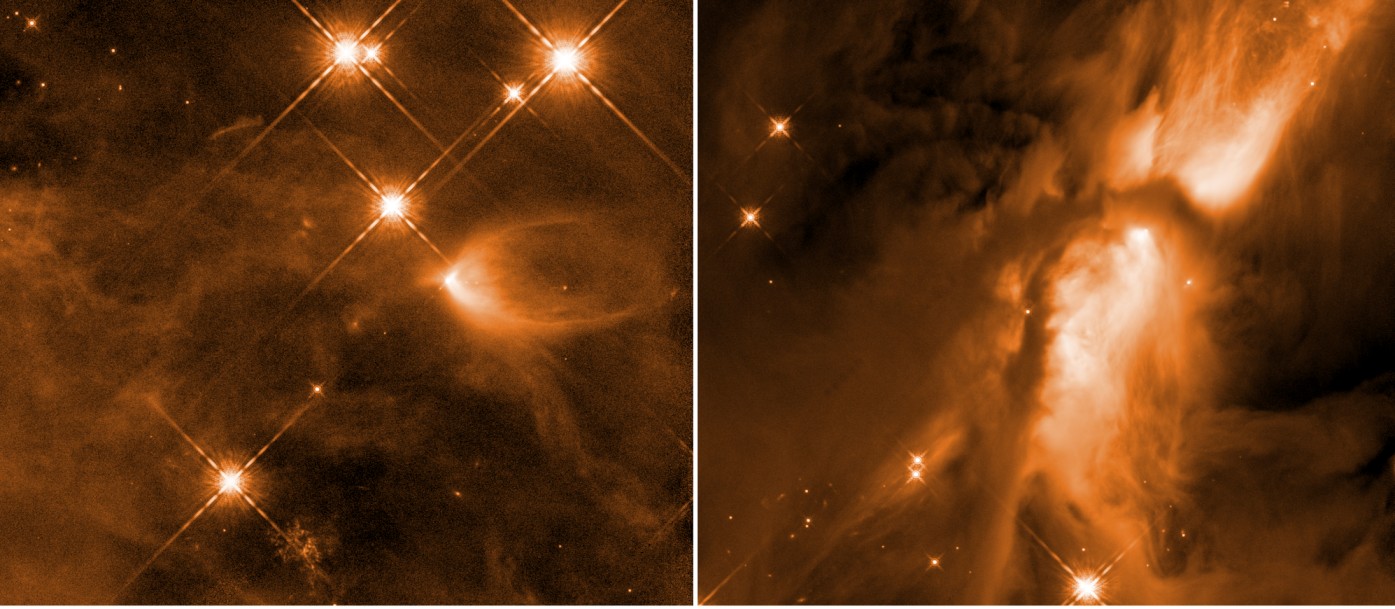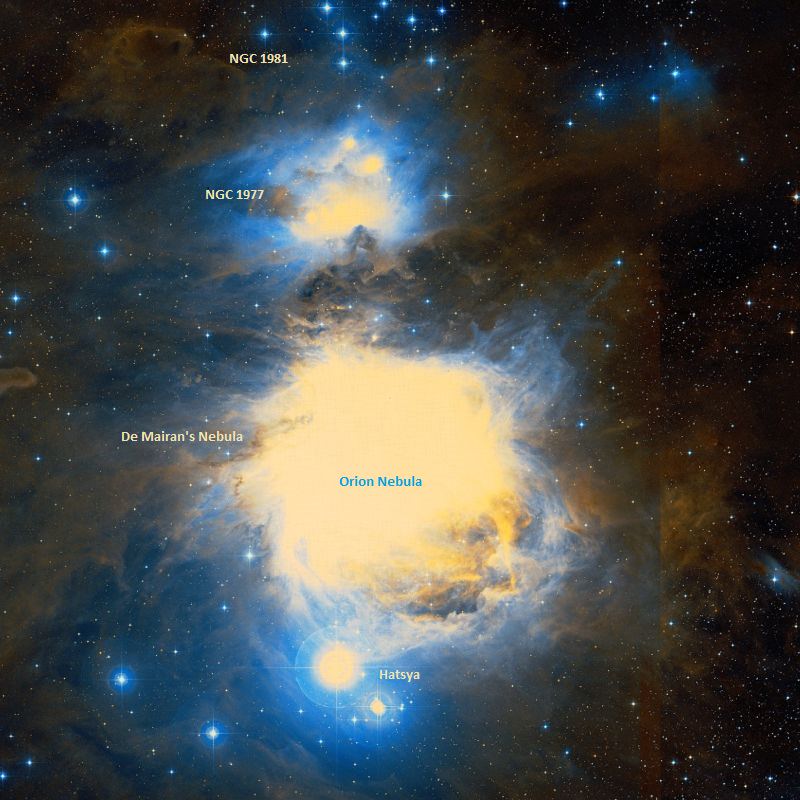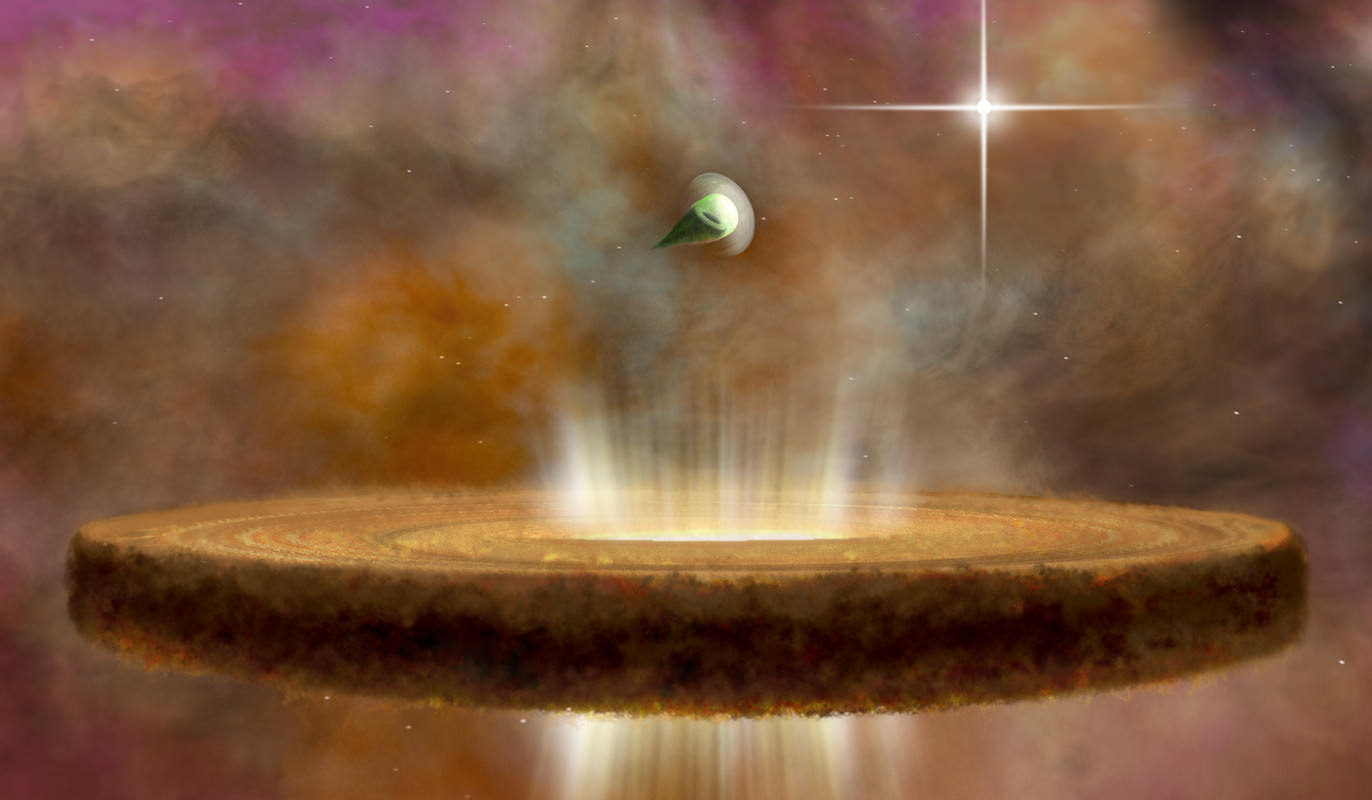We thought we understood how stars are formed. It turns out, we don’t. Not completely, anyway. A new study, recently conducted using data from the Hubble Space Telescope, is sending astronomers back to the drawing board to rewrite the accepted model of stellar formation.
Continue reading “Newly Forming Stars Don’t Blast Away Material as Previously Believed. So Why Do They Stop Growing?”Planets Form in Just a Few Hundred Thousand Years
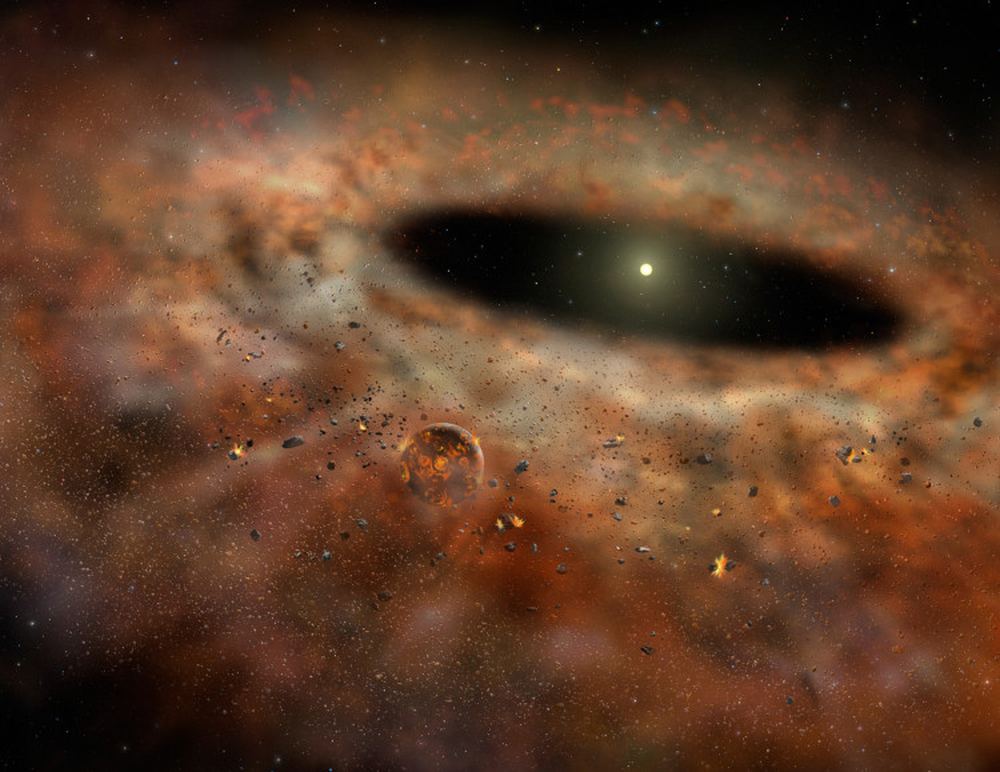
Astronomers like to observe young planets forming in circumstellar debris disks, the rotating rings of material around young stars. But when they measure the amount of material in those disks, they don’t contain enough material to form large planets. That discrepancy has puzzled astronomers.
The answer might come down to timing.
A new study suggests that planets form much quicker than astronomers think.
Continue reading “Planets Form in Just a Few Hundred Thousand Years”Newborn Stars in the Orion Nebula Prevent Other Stars from Forming

The Orion Nebula is one of the most observed and photographed objects in the night sky. At a distance of 1350 light years away, it’s the closest active star-forming region to Earth.
This diffuse nebula is also known as M42, and has been studied intensely by astronomers for many years. From it, astronomers have learned a lot about star formation, planetary system formation, and other bedrock topics in astronomy and astrophysics. Now a new discovery has been made which goes against the grain of established theory: stellar winds from newly-formed massive stars may prevent other stars from forming in their vicinity. They also play a much larger role in star formation, and in galaxy evolution, than previously thought.
Continue reading “Newborn Stars in the Orion Nebula Prevent Other Stars from Forming”Messier 43 – the De Marian’s Nebula
Welcome back to Messier Monday! In our ongoing tribute to the great Tammy Plotner, we take a look at Orion’s Nebula’s “little brother”, the De Marian’s Nebula!
During the 18th century, famed French astronomer Charles Messier noted the presence of several “nebulous objects” in the night sky. Having originally mistaken them for comets, he began compiling a list of them so that others would not make the same mistake he did. In time, this list (known as the Messier Catalog) would come to include 100 of the most fabulous objects in the night sky.
One of these if the diffuse nebula known as the De Marian’s Nebula (aka. Messier 43). Located in the direction of the Orion constellation (in close proximity to the Orion Nebula), this nebula lies at a distance of 1,600 light years from Earth. Together with the Orion Nebula, it is part of one of the most active star-forming regions visible in the night sky.
Description:
The diffuse nebula M43 surrounds the variable star N U Orionis (HD 37061) – a rather cool, young star cooking in a rich HII region. But is the light that’s reaching us actually coming through a tunnel in this dusty cloud? As Karl Wurm and explained in a 1970 study:
“Most of the areas with identical monochromatic features show a high deficiency of cluster stars correlated with a low surface brightnesss and a reduced gas density. This is explained by an opaqueness of the emission strata in the direction in the line of sight and a position of the same nearer to the observer than the extension of the cluster. There appear surface structures at large distances from the Trapezium which show a correlation between the intensity of scattered star light and the intensity of the emission of the higher ions ([Oiii], [Neiii]). This observation is considered as a proof that canals through the nebular cloud complex allow in some directions the exciting radiation to reach large distances from the star without having suffered an appreciable absorption or scattering.”
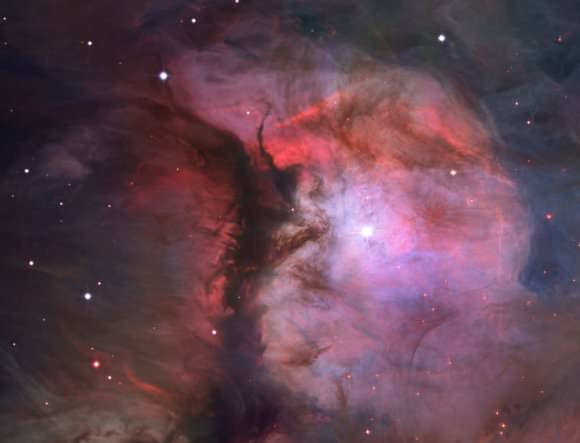
However, N U is far from being alone…. The whole complex is littered with stars being born! As Bo Reipurth (et al), stated in a 1999 study:
“The OMC-2/3 molecular clouds contain one of the highest concentrations of protostars known in nearby molecular clouds. We have observed an area of about 6 × 15 (0.8 pc × 2 pc) covering the OMC-2/3 region with the Very Large Array in the D configuration at 3.6 cm, matching well the area of a recent 1300 m survey. We detected 14 sources, of which it is highly probable that 11 sources are either protostars or very young stars. This testifies to the star-forming activity and extreme youth of the OMC-2/3 region. The 3.6 cm flux is free-free emission probably due to shocks in outflowing material. Three of the sources are extended even with the relatively low resolution of the present observations, and two of these may be collimated radio jets. The large fraction of submillimeter continuum sources that have a radio continuum counterpart is evidence that outflow is already common at the very earliest evolutionary stages. No relation is found between the radio continuum flux and the 1300 m flux of the associated submillimeter dust clumps.”
History of Observation:
In 1731, Jean-Jacques Dortous de Mairan was the first to notice this independent portion of the Orion nebula, stating:
“Finally I will add that close to the luminous space in Orion [M42], one sees the star d of Huygens [NU Orionis] currently (1731) surrounded by a brilliance very similar to that which produces, as I believe, the atmosphere of our Sun, if it were dense enough and extensive enough to be visible in Telescopes at a similar distance. See it in the form and the situation [given by] D, according to what was determined with the Reticule.”
On March 4, 1771, Charles Messier would also come to the same conclusion as he states in his observing notes:
“The star which is above, and has little distance from that nebula, and of which is spoken in the Traite de l’Aurore boreale [Treat of the Northern Light] by M. de Mairan is surrounded, and equally by a very thin light; the star doesn’t have the same brilliance as the four of the great nebula: its light is pale, and it appears covered by fog. I determined its position; its right ascension was 81d 3′ 0″, and its declination 5d 26′ 37″ south.”
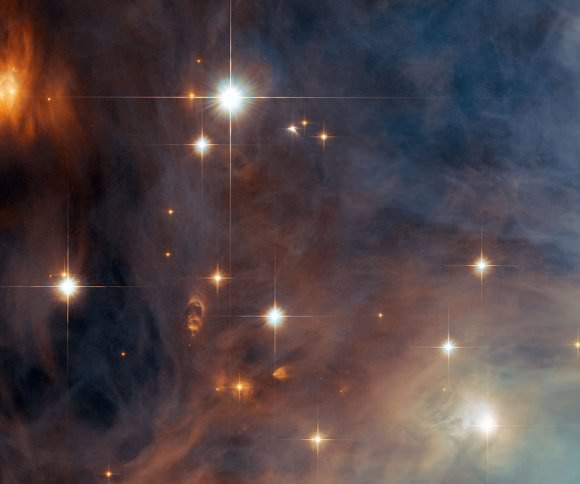
While Sir William Herschel was very careful not to assign his own catalog numbers to Messier Objects, he, too, was fascinated by the M43 region. In his personal notes he writes:
“In the year 1774, the 4th of March, I observed the nebulous star, which is the 43d of the Connoissance des Temps and is not many minutes north of the great nebula; but at the same time I also took notice of two similar, but much smaller nebulous stars; one on each side of the large one, and at nearly equal distance from it. Fig. 37 is a copy of the drawing which was made at the time of observation.
“In 1783, I reexamined the nebulous star, and found it to be faintly surrounded with a circular glory of whitish nebulosity, faintly joined to the great nebula. About the latter end of the same year I remarked that it was not equally surrounded, but most nebulous toward the south.
“In 1784, I began to entertain an opinion that the star was not connected with the nebulosity of the great nebula in Orion, but was one of those which are scattered over that part of the heavens.
“In 1801, 1806, and 1810 this opinion was fully confirmed, by the gradual change which happened in the great nebula, to which the nebulosity surrounding this star belongs. For the intensity of the light about the nebulous star had by this time been considerably reduced, by attenuation or dissipation of nebulous matter; and it seemed now to be pretty evident that the star is far behind the nebulous matter, and that consequently its light in passing through it is scattered and deflected, so as to produce the appearance of a nebulous star. A similar phenomenon may be seen whenever a planet or a star of the 1st or 2nd magnitude happens to be involved in haziness; for a diffused circular light will then be seen, to which, but in a much inferior degree, that which surrounds this nebulous star bears a great resemblance.
“When I reviewed this interesting object in December 1810, I directed my attention particularly to the two small nebulous stars, by sides of the large one, and found that they were perfectly free from every nebulous appearance; which confirmed not only my former surmise of the great attenuation of the nebulosity, but also proved that their former nebulous appearance had been entirely the effect of the passage of their feeble light through the nebulous matter spread out before them.
The 19th of January 1811, I had another critical examination of the same object in a very clear view through the 40-feet telescope; but notwithstanding the superior light of this instrument, I could not perceive any remains of nebulosity about the two small stars, which were perfectly clear, and in the same situation, where about thirty-seven years before I had seen them involved in nebulosity.”
May this wonderful region entertain your brain for as many years as it did Bill Herschel!
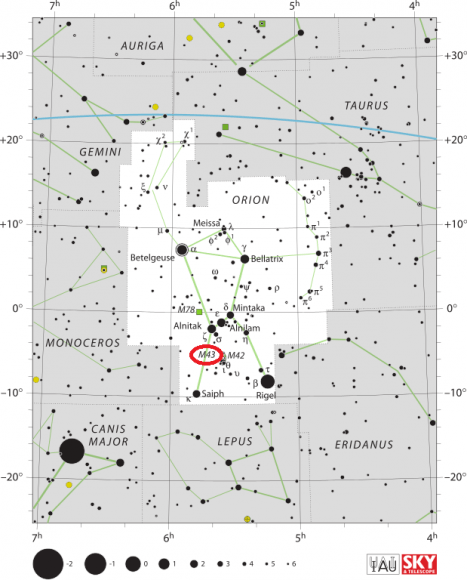
Locating Messier 43:
Locating M43 is as easy as locating… well… M42! This small star cluster accompanied by an emission/reflection nebula just to the north of the Orion Nebula’s “Trapezium” region is often mistake for part of the great nebula itself. However, if you look closely, you’ll see the two are separated by a dark dust lane.
Begin by locating the asterism of three stars known as Orion’s Belt. If you cover it with your fist held at arm’s length in a “thumb’s down” gesture with your left hand, the tip of your thumb will just about mark the correct spot in the sky. From a dark location when no Moon is present, you can easily see the haze of the Orion nebula surrounding the stars in the “sword” asterism. While it is easily seen in binoculars on a dark night, it will fade significantly under light pollution or moonlight.
And here are the quick facts on Messier 43 to help you get started:
Object Name: Messier 43
Alternative Designations: M43, NGC 1982, De Mairan’s Nebula, Companion of the Orion Nebula
Object Type: Emission/Reflection Nebula and Open Cluster
Constellation: Orion
Right Ascension: 05 : 35.6 (h:m)
Declination: -05 : 16 (deg:m)
Distance: 1.3 (kly)
Visual Brightness: 9.0 (mag)
Apparent Dimension: 20×15 (arc min)
We have written many interesting articles about Messier Objects here at Universe Today. Here’s Tammy Plotner’s Introduction to the Messier Objects, , M1 – The Crab Nebula, M8 – The Lagoon Nebula, and David Dickison’s articles on the 2013 and 2014 Messier Marathons.
Be to sure to check out our complete Messier Catalog. And for more information, check out the SEDS Messier Database.
Sources:
Messier 42 – The Orion Nebula

Welcome back to Messier Monday! In our ongoing tribute to the great Tammy Plotner, we take a look at that Great and most brightest of nebulae – the Orion Nebula!
During the 18th century, famed French astronomer Charles Messier noted the presence of several “nebulous objects” in the night sky. Having originally mistaken them for comets, he began compiling a list of them so that others would not make the same mistake he did. In time, this list (known as the Messier Catalog) would come to include 100 of the most fabulous objects in the night sky.
One of these objects is the Orion Nebula, a diffuse nebula situated just south of Orion’s Belt in the Orion constellation. Located between 1,324 and 1,364 light years distant, it is the closest massive star forming region to Earth. Little wonder then why it is the brightest nebula in the night sky and can be seen on a clear evening with the naked eye.
Description:
Known as “The Great Orion Nebula,” let’s learn what makes it glow. M42 is a great cloud of gas spanning more than 20,000 times the size of our own solar system and its light is mainly florescent. For most observers, it appears to have a slight greenish color – caused by oxygen being stripped of electrons by radiation from nearby stars.
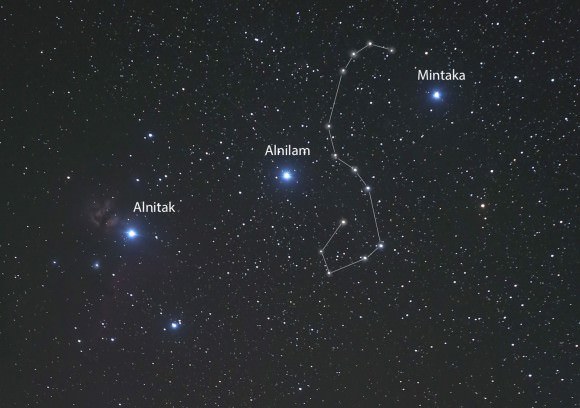
At the heart of this immense region is an area known as the “Trapezium” – its four brightest stars form perhaps the most celebrated multiple star system in the night sky. The Trapezium itself belongs to a faint cluster of stars now approaching main sequence and resides in an area of the nebula known as the “Huygenian Region” (named after 17th century astronomer and optician Christian Huygens who first observed it in detail).
Buried amidst the bright ribbons and curls of this cloud of predominately hydrogen gas are many star forming regions. Appearing like “knots,” these Herbig-Haro objects are thought to be stars in the earliest stages of condensation. Associated with these objects are a great number of faint red stars and erratically luminous variables – young stars, possibly of the T Tauri type.
There are also “flare stars,” whose rapid variations in brightness mean an ever changing view. “Orion may seem very peaceful on a cold winter night, but in reality it holds very massive, luminous stars that are destroying the dusty gas cloud from which they formed,” said Tom Megeath, an astronomer at the Harvard-Smithsonian Center for Astrophysics.
While studying M42, you’ll note the apparent turbulence of the area – and with good reason. The “Great Nebula’s” many different regions move at varying speeds. The rate of expansion at the outer edges may be caused by radiation from the very youngest stars present. Said Massimo Roberto, an astronomer at the Space Science Telescope Institute in Baltimore:
“In this bowl of stars we see the entire formation history of Orion printed into the features of the nebula: arcs, blobs, pillars and rings of dust that resemble cigar smoke. Each one tells a story of stellar winds from young stars that impact the environment and the material ejected from other stars.”
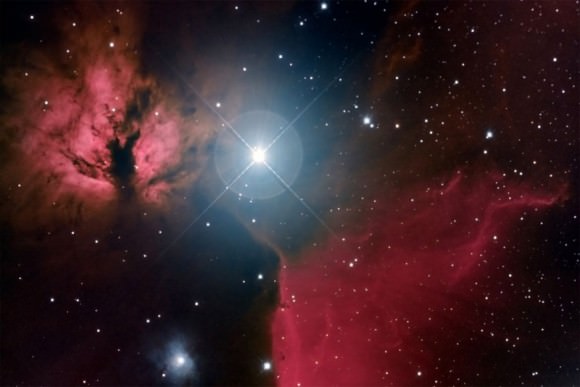
Although M42 may have been luminous for as long as 23,000 years, it is possible that new stars are still forming, while others were ejected by gravitation – known as “runaway” stars. A tremendous X-ray source (2U0525-06) is quite near the Trapezium and hints at the possibility of a black hole present within M42. The Trapezium’s stellar winds also are responsible for the formation of stars inside the nebula – their shock waves compressing the medium and igniting starbirth.
“When you look closely, you see that the nebula is filled with hundreds of visible shock waves,” said Bob O’Dell, an astronomer from Vanderbilt University. O’Dell was fortunate enough to use Hubble to map Orion’s stellar winds and create a map of two of Orion’s three star-forming regions… Regions where the winds have been blowing continuously for nearly 1,500 years!
What else have we learned about the Great Orion nebula in recent years? Try the discovery of 13 drifting gas planets. These rare, “free-floating” objects were confirmed by Patrick Roche of the University of Oxford and Philip Lucas of the University of Hertfordshire just before the turn of the century. They were found with the Hubble Space Telescope while looking for faint stars and brown dwarfs. As he explained:
“The objects are likely to be large gas planets similar in size to Jupiter and consisting primarily of hydrogen and helium. From the measured brightness and the known distance to the Orion nebula, we knew they did not have enough material for any nuclear processing in their interiors.”
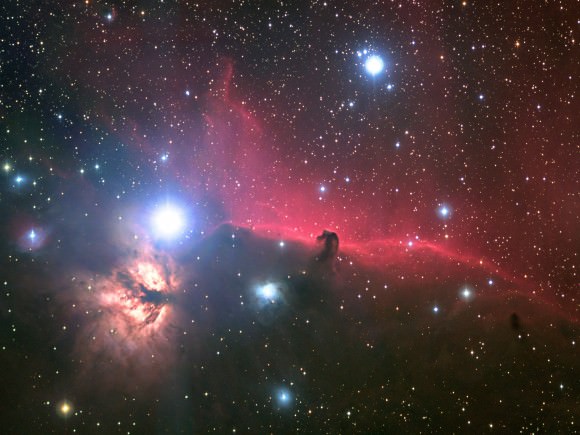
Chances are very good these planets may be failed stars – much like our own Jupiter. But these planets don’t orbit a star the same way our solar system’s planets orbit the Sun… they simply roam around. Dr. Roche said that the 13 objects “probably formed in a different way from the planets in our solar system” in that they were not made “out of the residue of material left over from the birth of the sun.”
Instead, they formed “like stars via the collapse of a cloud of cold gas,” explained Lucas. “But they possess most of the physical properties and structure of gas giant planets,” added Lucas.
History of Observation:
Messier 42 was possibly discovered 1610 by Nicholas-Claude Fabri de Peiresc and was recorded by by Johann Baptist Cysatus, Jesuit astronomer, in 1611. For fans of the great Galileo, he was the first to mention the Trapezium cluster in 1617, but did not see the nebula. (However, do not despair! For it is my belief that he was simply using too much magnification and therefore could not see the extent of what he was looking at.)
The first known drawing of the Orion nebula was created by Giovanni Batista Hodierna, and after all of these documents were lost, the Orion nebula was once again credited to Christian Huygens 1656, documented by Edmund Halley in 1716. It then went on to Jean-Jacques d’Ortous de Mairan in his nebulae descriptions, to be added by Philippe Loys de Chéseaux to his list, expounded by Guillaume Legentil in his review.
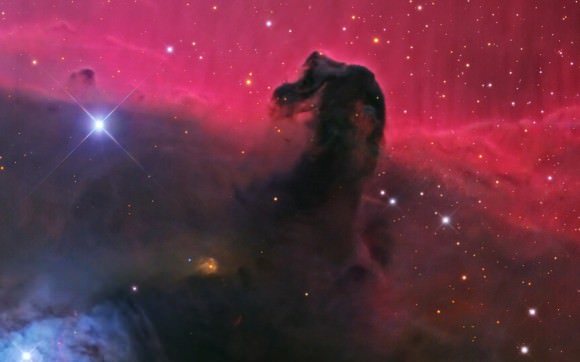
At last, Charles Messier added the nebula to his catalog on March 4, 1769. As he wrote of the stunning objectL
“The drawing of the nebula in Orion, which I present at the Academy, has been traced with the greatest care which is possible for me. The nebula is represented there as I have seen it several times with an excellent achromatic refractor of three and a half feet focal length, with a triple lens, of 40 lignes [3.5 inches] aperture, and which magnifies 68 times. This telescope made in London by Dollond, belongs to M. President de Saron. I have examined that nebula with the greatest attention, in an entirely serene sky, as follows: February 25 & 26, 1773. Orion in the Meridian. March 19, between 8 & 9 o’clock in the evening. [March] 23, between 7 & 8 o’clock. The 25th & 26th of the same month, at the same time. These combined observations and the drawings brought together, have enabled me to represent with care and precision its shape and its appearances.
“This drawing will serve to recognize, in following times, if this nebula is subject to any changes. There may be already cause to presume this; for, if one compares this drawing with those given by MM. Huygens, Picard, Mairan and by le Gentil, one finds there such a change that one would have difficulty to figure out that this was the same. I will make these observations in the following with the same telescope and the same magnification. In the figure which I give, the circle represents the field of the telescope in its true aperture; it contains the Nebula and thirty Stars of different magnitudes. The figure is inverted, as it is shown in the instrument; one recognizes there also the extension and the limits of this nebula, the sensible difference between its clearest or most apparent light with that which merges gradually with the background of the sky. The jet of light, directed from the star no. 8 to the star no. 9, passing by a small star of the 10th magnitude, which is extremely rare, as well as the light directed to the star no. 10, and that which is opposite, where there are the eight stars contained in the nebula; among these stars, there is one of the eighth magnitude, six of the tenth, and the eighth of the eleventh magnitude. M. de Mairan, in his Traite de l’Aurore Boreale, speaks of the star no. 7. I report it in my drawing below such as it is at present, and as I have seen; so to speak surrounded by a thin nebulosity. In the night of October 14 to 15, 1764, in a serene sky, I determined with regard to Theta in the nebula, the positions of the more apparent stars in right ascension and declination, by the means of a micrometer adapted to a Newtonian telescope of 4 1/2 feet length. These stars are numbered up to ten; I have reported them in the drawing containing the field of the telescope; and an eleventh of them is beyond the circle. The positions of the stars which are not marked with numbers have been fixed by estimating their relative alignments. One will know easily also the magnitude of the Stars by the model which I have reported on the figure. Those of the tenth and the eleventh magnitude are absolutely telescopic and very difficult to find.”
However, it would be Sir William Herschel who would devote much love, time, and attention to the Great Orion Nebula – even though his findings would never be made public. As a true master observer, he had quite a talent for sensing what truly might lay beyond the boundary:
“In 1783, I reexamined the nebulous star, and found it to be faintly surrounded with a circular glory of whitish nebulosity, faintly joined to the great nebula. About the latter end of the same year I remarked that it was not equally surrounded, but most nebulous toward the south. In 1784 I began to entertain an opinion that the star was not connected with the nebulosity of the great nebula in Orion, but was one of those which are scattered over that part of the heavens. In 1801, 1806, and 1810 this opinion was fully confirmed, by the gradual change which happened in the great nebula, to which the nebulosity surrounding this star belongs. For the intensity of the light about the nebulous star had by this time been considerably reduced, by attenuation or dissipation of nebulous matter; and it seemed now to be pretty evident that the star is far behind the nebulous matter, and that consequently its light in passing through it is scattered and deflected, so as to produce the appearance of a nebulous star. A similar phenomenon may be seen whenever a planet or a star of the 1st or 2nd magnitude happens to be involved in haziness; for a diffused circular light will then be seen, to which, but in a much inferior degree, that which surrounds this nebulous star bears a great resemblance.”
But of course, the great Sir William Herschel also had nights from his many notes on M42 where he simply said: “The nebula in Orion which I saw by the front-view was so glaring and beautiful that I could not think of taking any place of its extent.”
Locating Messier 42:
Finding Messier 42 is very easy from a dark sky location by centering on the glowing region in the center of Orion’s “sword”. However, from urban locations, these stars might not be visible, so aim your binoculars or telescope about a fist width south of the three prominent stars that make the asterism known as Orion’s Belt. It’s a very bright and large object well suited to all sky conditions and instruments!
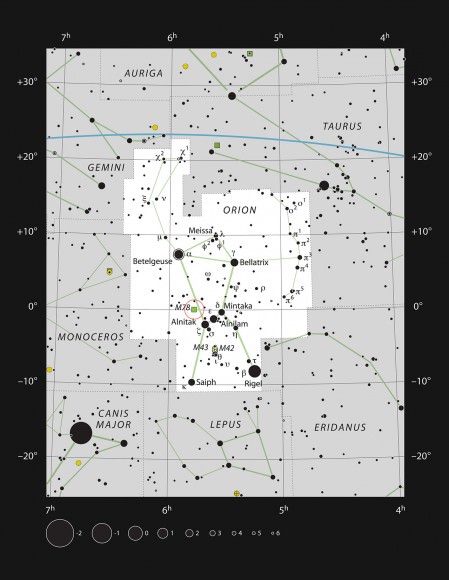
Remember to use low power to get the full majesty of M42 and to increase magnification to study various regions. And trust us when we tell you, you are in for some pretty awesome viewing!
And of course, here are the quick facts on Messier 42 to help you get started:
Object Name: Messier 42
Alternative Designations: M42, NGC 1976, The Great Orion Nebula, Home of the Trapezium
Object Type: Emission and Reflection Nebula with Open Galactic Star Cluster
Constellation: Orion
Right Ascension: 05 : 35.4 (h:m)
Declination: -05 : 27 (deg:m)
Distance: 1.3 (kly)
Visual Brightness: 4.0 (mag)
Apparent Dimension: 85×60 (arc min)
We have written many interesting articles about Messier Objects here at Universe Today. Here’s Tammy Plotner’s Introduction to the Messier Objects, , M1 – The Crab Nebula, M8 – The Lagoon Nebula, and David Dickison’s articles on the 2013 and 2014 Messier Marathons.
Be to sure to check out our complete Messier Catalog. And for more information, check out the SEDS Messier Database.
Sources:
Space Station Back At Dusk / See Orion’s Curlicue and Five Dawn Planets
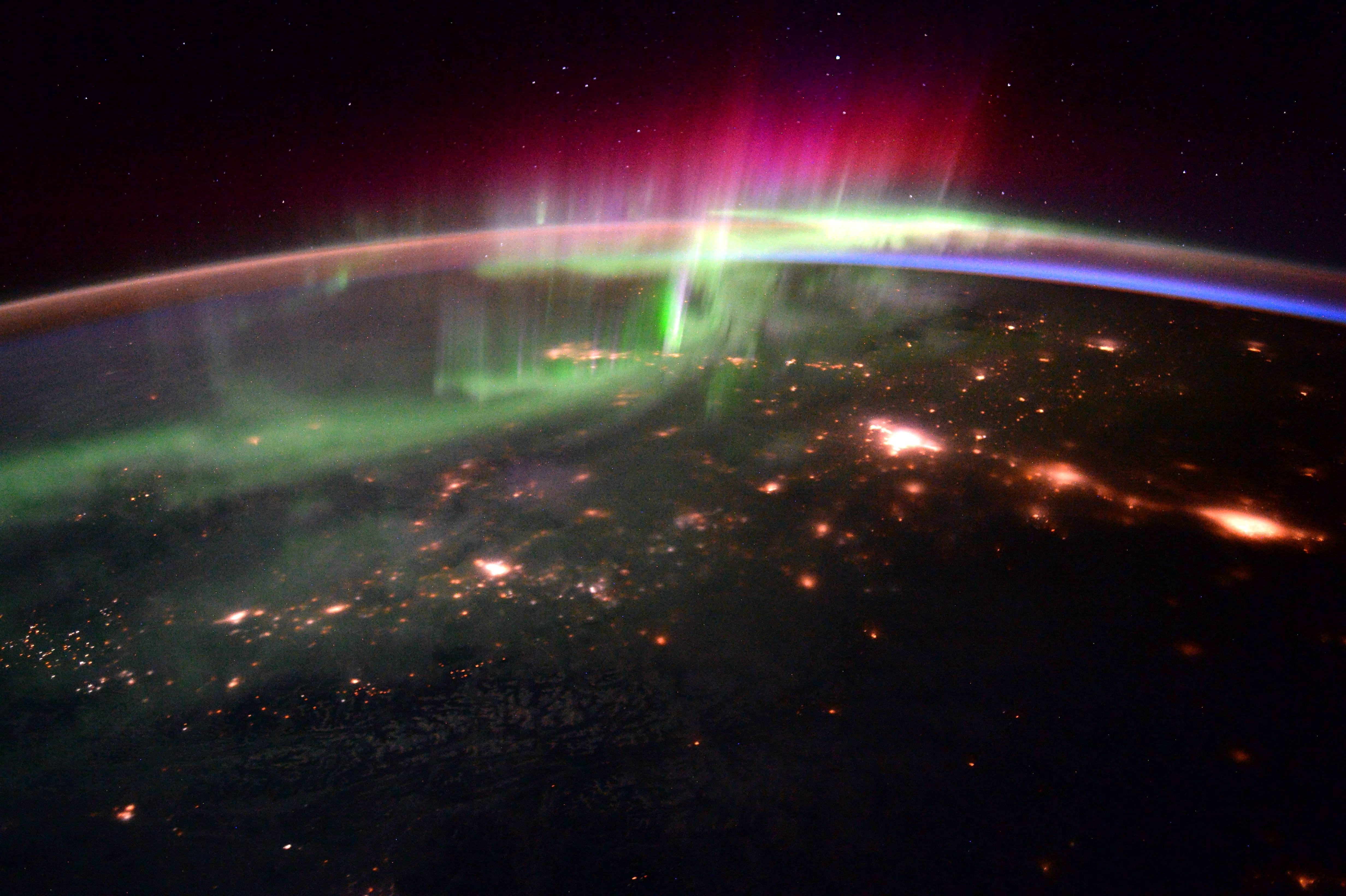
I hadn’t been paying attention, so I was pleasantly surprised two nights ago to see the International Space Station (ISS) made a bright pass in the southwestern sky. A quick check revealed that another round of evening passes had begun for locations across the central and northern U.S., Canada and Europe. I like the evening ones because they’re so much convenient to view than those that occur at dawn. You can find out when the space station passes over your house at NASA’s Spot the Station site or Heavens Above.
The six-member Expedition 46 crew are wrapping up their work week on different types of research including botany, bone loss and pilot testing. Plants are being grown on the International Space Station so future crews can learn to become self-sustainable as they go farther out in space. While they work their jobs speeding at more than 17,000 mph overhead, we carry on here on the surface of the blue planet.
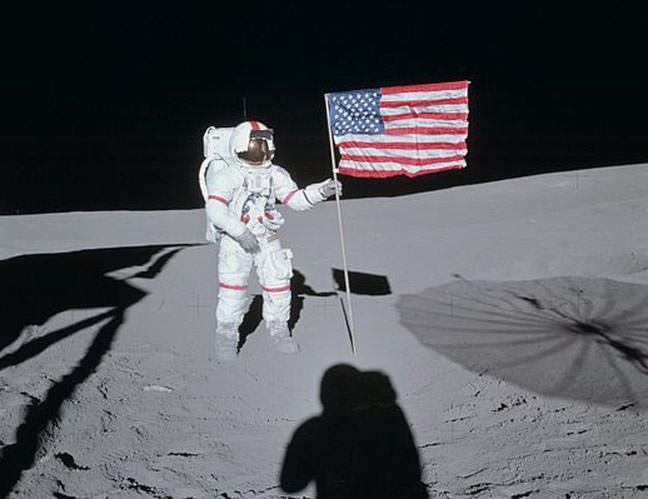
U.S. astronaut Scott Kelly regularly tweets photos from the station and recently noted the passing of Apollo 14 astronaut Edgar Mitchell, who died Thursday at age 85 on the eve of the 45th anniversary of his lunar landing on February 5, 1971. Mitchell was one of only 12 people to walk on the moon and described the experience to the UK Telegraph in 2014:
Relive the Mitchell’s Apollo 14 mission to the moon in 9 minutes and 57 seconds
“Looking at Earth from space and seeing it was a planet in isolation … that was an experience of ecstasy, realizing that every molecule in our bodies is a system of matter created from a star hanging in space. The experience I had was called Samadhi in the ancient Sanskrit, a feeling of overwhelming joy at seeing the Earth from that perspective.”
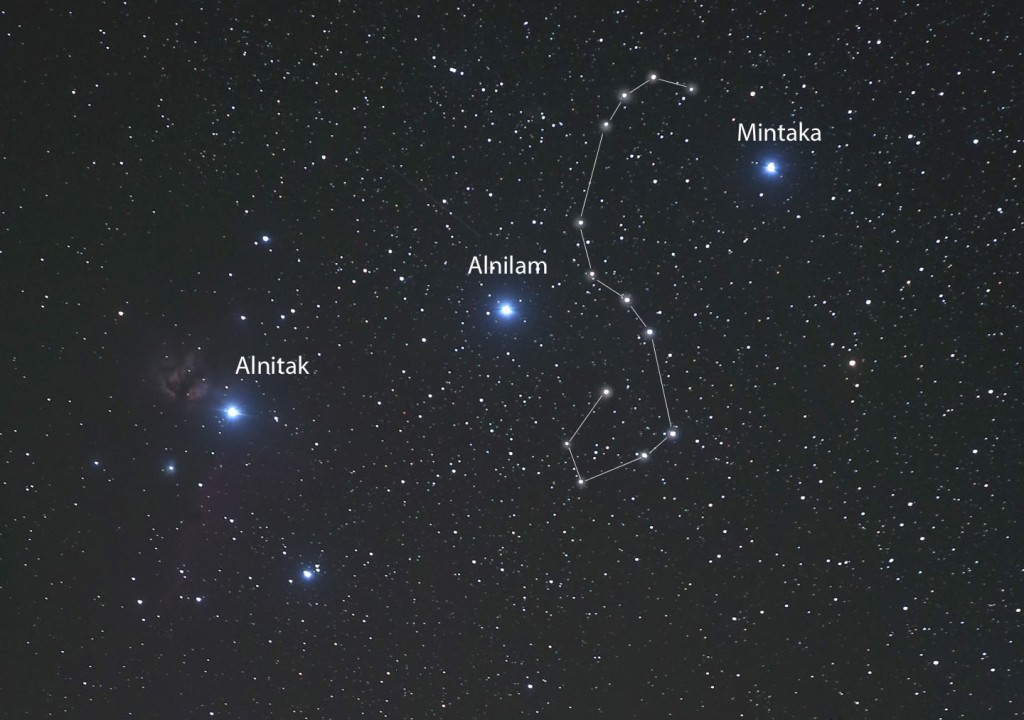
Only a human could stand in so barren and forbidding a place and experience such profound joy. You don’t have to go to the moon to be moved by sights in the night. Just step outside and watch the ISS glide by or grab a pair of binoculars and aim them at Orion’s Belt. Orion stands due south around 8 o’clock in in mid-February practically shouting to be looked at.
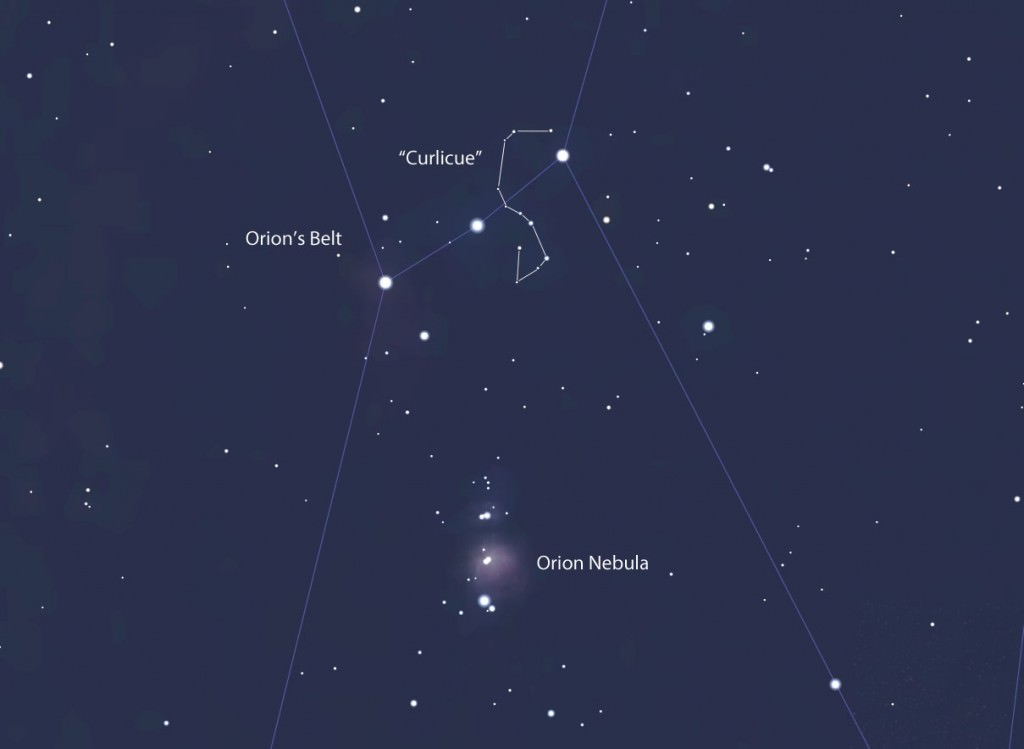
The Belt is lovely enough, but its surroundings glitter with stars just below the naked eye limit, in particular a little curlicue or “S” between Alnilam and Mintaka composed of 6th and 7th magnitude stars. Look for it in any pair of binoculars and don’t stop there. Take a few minutes to sweep the area and enjoy the starry goodness about then drop a field of view south for a look at the Orion Nebula. Inside this fuzzy spot 10 light years across and 1,350 light years away, hundreds of new stars are incubating, waiting for the day they can blaze forth like their compadres that make up the rest of Orion.
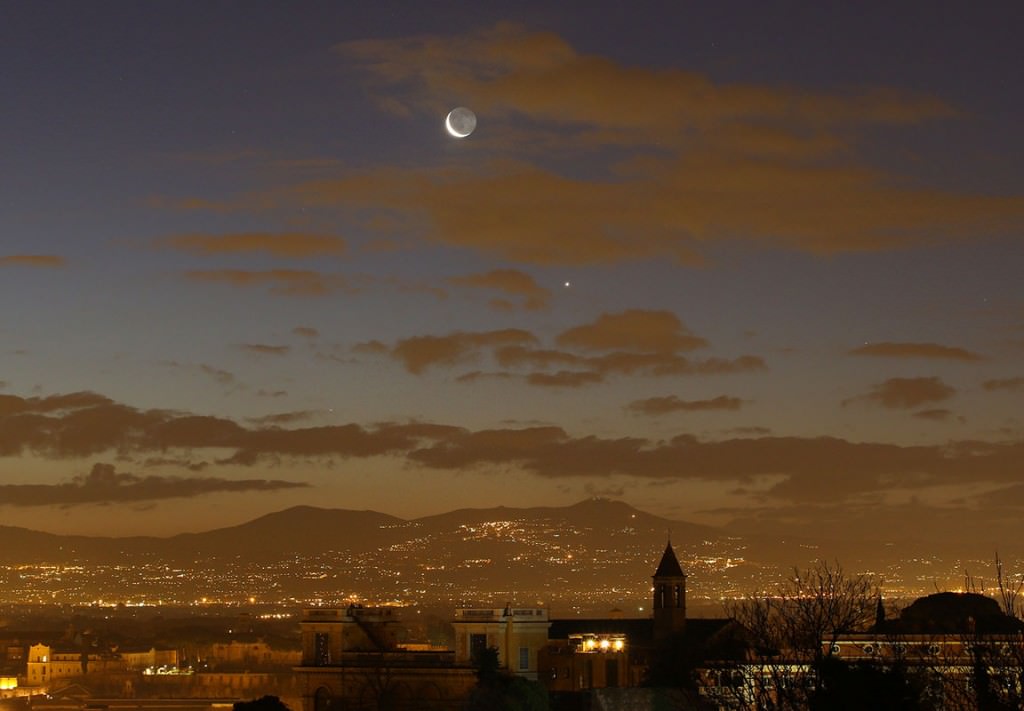
After touting the advantages of evening sky watching, forgive me if I also direct you to the morning sky and potential sleep loss. Although the waning crescent moon has now departed the scene, the wonderful alignment of Mercury, Venus, Saturn, Mars and Jupiter remains visible in the coming week even as Mercury slowly sinks back toward the eastern horizon. If you haven’t seen this “gang of 5”, set your alarm for a look starting about an hour before sunrise.
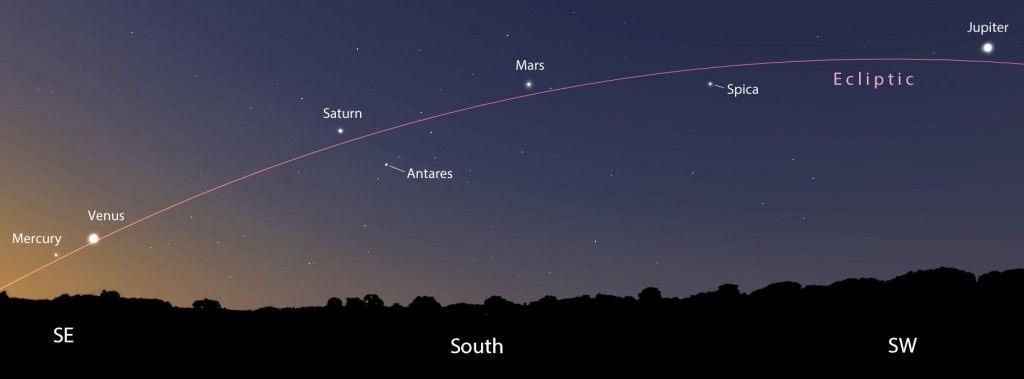
Find a location with as wide open a view as possible of the southeastern horizon. Jupiter, Mars and Saturn are plenty high up at that time and easy to spot, but Venus and Mercury hover only 5°-10° high. Both will pose no problem if you can get the trees and buildings out of the way! By the end of the coming week, Mercury will become challenging and then slip away.
Clear skies!
What Was Here Before the Solar System?
The Solar System is 4.5 billion years old, but the Universe is much older. What was here before our Solar System formed?
The Solar System is old. Like, dial-up-fax-machine-old. 4.6 billion years to be specific. The Solar System has nothing on the Universe. It’s been around for 13.8 billion years, give or take a few hundred million. That means the Universe is three times older than the Solar System.
Astronomers think the Milky Way, is about 13.2 billion years old; almost as old as the Universe itself. It formed when smaller dwarf galaxies merged together to create the grand spiral we know today. It turns out the Milky Way has about 8.6 billion years of unaccounted time. Billions and billions of years to get up to all kinds of mischief before the Solar System showed up to keep an eye on things.
Our Galaxy takes 220 million years to rotate, so it’s done this about 60 times in total. As it turns, it swirls and mixes material together like a giant space blender. Clouds of gas and dust come together into vast star forming regions, massive stars have gone supernova, and then the clusters themselves have been torn up again, churning the stars into the Milky Way. This happens in the galaxy’s spiral arms, where the areas of higher density lead to regions of star formation.
So let’s go back, more than 4.6 billion years, before there was an Earth, a Sun, or even a Solar System. Our entire region was gas and dust, probably within one of the spiral arms. Want to know what it looked like? Some of your favorite pictures from the Hubble Space Telescope should help.
Here’s the Orion, Eagle, and the Tarantula Nebulae. These are star forming regions. They’re clouds of hydrogen left over from Big Bang, with dust expended by aging stars, and seeded with heavier elements formed by supernovae.
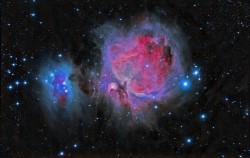
After a few million years, regions of higher density began forming into stars, both large and small. Let’s take a look at a star-forming nebula again. See the dark knots? Those are newly forming stars surrounded by gas and dust in the stellar nursery.
You’re seeing many many stars, some are enormous monsters, others are more like our Sun, and some smaller red dwarfs. Most will eventually have planets surrounding them – and maybe, eventually life? If this was the environment, where are all those other stars?
Why do I feel so alone? Where are all our brothers and sisters? Where’s all the other stuff that’s in that picture? Where’s all my stuff?
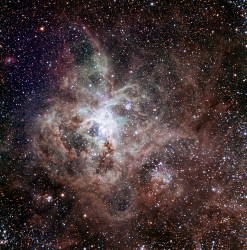
Apparently nature hates a messy room and a cozy stellar nest. The nebula that made the Sun was either absorbed into the stars, or blown away by the powerful stellar winds from the largest stars. Eventually they cleared out the nebula, like a fans blowing out a smoky room.
At the earliest point, our solar nebula looked like the Eagle Nebula, after millions of years, it was more like the Pleiades Star Cluster, with bright stars surrounded by hazy nebulosity. It was the gravitational forces of the Milky Way which tore the members of our solar nursery into a structure like the Hyades Cluster. Finally, gravitational interactions tore our cluster apart, so our sibling stars were lost forever in the churning arms of the Milky Way.
We’ll never know exactly what was here before the Solar System; that evidence has long been blown away into space. But we can see other places in the Milky Way that give us a rough idea of what it might have looked like at various stages in its evolution.
What should we call our original star forming nebula? Give our own nebula a name in the comments below.
Virtual Star Party – May 4, 2014: It’s Galaxy Season!
Hosts: Fraser Cain and Scott Lewis
Astronomers: Gary Gonella, Andrew Dumbleton, Stuart Foreman, David Dickinson, Shahrin Ahmad and special guest Henna Khan from Bombay, India
Tonight’s Views:
the Moon’s surface
M44 Beehive Cluster
Neutron Star B224 from HST
All-Sky View
Mars with ice caps and Hellas Basin visible
Comet C/2012 K1 PanSTARRS
Stuart demonstrating how to work with software to process images
M51a Whirlpool Galaxy
M53 Globular Cluster
Rosette Nebula – NGC 2237, 2238, 2239 and 2246
Saturn
Horsehead Nebula (Barnard 33 in emission nebula IC 434) and Flame Nebula (NGC 2024) with a satellite trail
NGC 5139 Omega Centauri
M42 Orion Nebula
M63 Sunflower Galaxy
NGC 7635 Bubble Nebula
Large and Small Magellanic Clouds
We hold the Virtual Star Party every Sunday night as a live Google+ Hangout on Air. We begin the show when it gets dark on the West Coast. If you want to get a notification, make sure you circle the Virtual Star Party on Google+. You can watch on our YouTube channel or here on Universe Today.
“Death Stars” Caught Blasting Proto-Planets
It’s a tough old universe out there. A young star has lots to worry about, as massive stars just beginning to shine can fill a stellar nursery with a gale of solar wind.
No, it’s not a B-movie flick: the “Death Stars of Orion” are real. Such monsters come in the form of young, O-type stars.
And now, for the first time, a team of astronomers from Canada and the United States have caught such stars in the act. The study, published in this month’s edition of The Astrophysical Journal, focused on known protoplanetary disks discovered by the Hubble Space Telescope in the Orion Nebula.
These protoplanetary disks, also known as “tadpoles” or proplyds, are cocoons of dust and gas hosting stars just beginning to shine. Much of this leftover material will go on to aggregate into planets, but nearby massive O-Type stars can cause chaos in a stellar nursery, often disrupting the process.
“O-Type stars, which are really monsters compared to our Sun, emit tremendous amounts of ultraviolet radiation and this can play havoc during the development of young planetary systems,” said astronomer Rita Mann in a recent press release. Mann works for the National Research Council of Canada in Victoria and is lead researcher on the project
Scientists used the Atacama Large Millimeter Array (ALMA) to probe the proplyds of Orion in unprecedented detail. Supporting observations were also made using the Submillimeter Array in Hawaii.
ALMA saw “first light” in 2011, and has already achieved some first rate results.
“ALMA is the world’s most sensitive telescope at high-frequency radio waves (e.g., 100-1000 GHz). Even with only a fraction of its final number of antennas, (with 22 operational out of a total planned 50) we were able to detect with ALMA the disks relatively close to the O-star while previous observatories were unable to spot them,” James Di Francesco of the National Research Council of Canada told Universe Today. “Since the brightness of a disk at these frequencies is proportional to its mass, these detections meant we could measure the masses of the disks and see for sure that they were abnormally low close to the O-type star.”
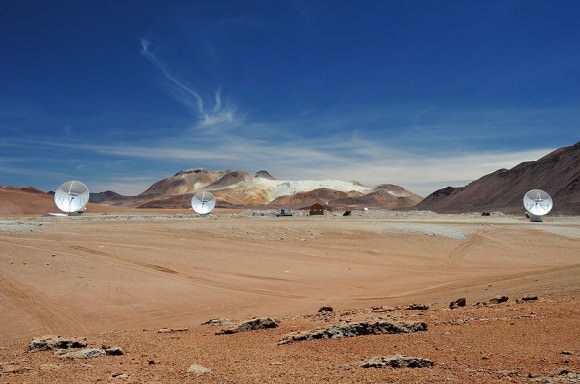
ALMA also doubled the number of proplyds seen in the region, and was also able to peer within these cocoons and take direct mass measurements. This revealed mass being stripped away by the ultraviolet wind from the suspect O-type stars. Hubble had been witness to such stripping action previous, but ALMA was able to measure the mass within the disks directly for the first time.
And what was discovered doesn’t bode well for planetary formation. Such protostars within about 0.1 light-years of an O-type star are consigned to have their cocoon of gas and dust stripped clean in just a few million years, just a blink of a eye in the game of planetary formation.
With a O-type star’s “burn brightly and die young” credo, this type of event may be fairly typical in nebulae during early star formation.
“O-type stars have relatively short lifespan, say around 1 million years for the brightest O-star in Orion – which is 40 times the mass of our Sun – compared to the 10 billion year lifespan of less massive stars like our Sun,” Di Francesco told Universe Today. “Since these clusters are typically the only places where O-stars form, I’d say that this type of event is indeed typical in nebulae hosting early star formation.”
It’s common for new-born stars to be within close proximity of each other in such stellar nurseries as M42. Researchers in the study found that any proplyds within the extreme-UV envelope of a massive star would have its disk shredded in short order, retaining on average less than 50% the mass of Jupiter total. Beyond the 0.1 light year “kill radius,” however, the chances for these proplyds to retain mass goes up, with researchers observing anywhere from 1 to 80 Jupiter masses of material remaining.
The findings in this study are also crucial in understanding what the early lives of stars are like, and perhaps the pedigree of our own solar system, as well as how common – or rare – our own history might be in the story of the universe.
There’s evidence that our solar system may have been witness to one or more nearby supernovae early in its life, as evidenced by isotopic measurements. We were somewhat lucky to have had such nearby events to “salt” our environment with heavy elements, but not sweep us clean altogether.
“Our own Sun likely formed in a clustered environment similar to that of Orion, so it’s a good thing we didn’t form too close to the O-stars in its parent nebula,” Di Francesco told Universe Today. “When the Sun was very young, it was close enough to a high-mass star so that when it blew up (went supernova) the proto-solar system was seeded with certain isotopes like Al-26 that are only produced in supernova events.”
This is the eventual fate of massive O-type stars in the Orion Nebula, though none of them are old enough yet to explode in this fashion. Indeed, it’s amazing to think that peering into the Orion Nebula, we’re witnessing a drama similar to what gave birth to our Sun and solar system, billions of years ago.
The Orion Nebula is the closest active star forming region to us at about 1,500 light years distant and is just visible to the naked eye as a fuzzy patch in the pommel of the “sword” of Orion the Hunter. Looking at the Orion Nebula at low power through a small telescope, you can just make out a group of four stars known collectively as the Trapezium. These are just such massive hot and luminous O-Type stars, clearing out their local neighborhoods and lighting up the interior of the nebula like a Chinese lantern.
And thus science fact imitates fiction in an ironic twist, as it turns out that “Death Stars” do indeed blast planets – or at least protoplanetary disks – on occasion!
Be sure to check out a great piece on ALMA on a recent episode of CBS 60 Minutes:
Read the abstract and the full (paywalled) paper on ALMA Observations of the Orion Proplyds in The Astrophysical Journal.
Astrophoto: Gorgeous Panorama of the Orion & Horsehead Nebulae and Orion’s Belt

Astrophotographer Terry Hancock has been working on this for several weeks and the results are fabulous. This panoramic view of the Orion region includes two of the most recognizable objects in this constellation — the Orion Nebula and the Horsehead Nebula. It also takes a look at the three bright stars of Orion’s belt Alnitak (to the left of the image), Alnilam and Mintaka. Additionally, it shows part of the Orion molecular cloud.
Wow!
More info on this image from Terry:
This is data I captured in January, February and early March 2014 over 8 nights using a QHY11S Monochrome CCD/Takahashi E-80 F2.8 from DownUnder Observatory in Fremont Michigan, USA.
190 individual exposures make up this 5 panel mosaic for a Total Exposure time of 11 hours
Equipment:
Camera: QHY11S monochrome CCD cooled to -20C
Optics: Takahashi Epsilon F2.8 ED-180 Astrograph
Mount: Paramount GT-1100S German Equatorial Mount (with MKS 4000)
Image Aquisition Maxim DL
Stacking and Calibrating: CCDStack
Registration of images in Registar
Post Processing Photoshop CS5
See more of Terry’s astrophotography at his Flickr page or G+.
Want to get your astrophoto featured on Universe Today? Join our Flickr group or send us your images by email (this means you’re giving us permission to post them). Please explain what’s in the picture, when you took it, the equipment you used, etc.

